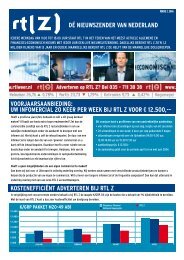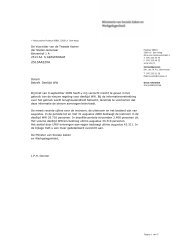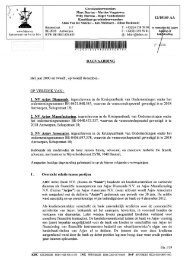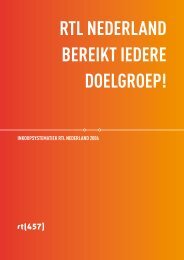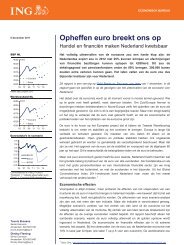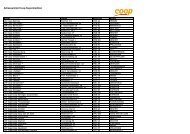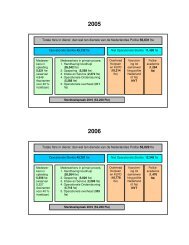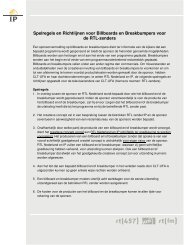Didier Duret - RTL.nl
Didier Duret - RTL.nl
Didier Duret - RTL.nl
You also want an ePaper? Increase the reach of your titles
YUMPU automatically turns print PDFs into web optimized ePapers that Google loves.
Work in progress<br />
Quarterly Outlook Q4 2012<br />
Investment<br />
Strategy
Quarterly Outlook Q4 2012<br />
<strong>Didier</strong> <strong>Duret</strong><br />
Chief Investment Officer,<br />
ABN AMRO Private Banking<br />
September 2012<br />
Work in progress<br />
The enormous efforts in progress since the start of the<br />
global financial crisis in 2008 seem finally to be showing<br />
some results, though there is still more to be done.<br />
However, the end of “muddling through” may be in sight.<br />
The European Central Bank has recently taken some<br />
uncharacteristically bold steps to protect the single currency,<br />
and certain indicators in the United States are starting to<br />
surprise on the upside.<br />
The global economy now faces political uncertainties:<br />
leadership change in China and possibly in the US, the US<br />
“fiscal cliff” at year-end, and the stringent measures<br />
required to ensure the euro’s survival. Investors should<br />
remain aware of these while pursuing progress on the value<br />
of their portfolios.<br />
The time is therefore ripe to abandon anxieties and with<br />
them, safe havens, and government bonds in particular.<br />
These have become especially expensive and should be<br />
avoided in favour of lower-rated investment-grade bonds,<br />
European equities and high-quality listed US property,<br />
among other asset classes. Selected hedge funds can also<br />
offer opportunities.<br />
Through these and other investment views, the ABN AMRO<br />
Private Banking Research & Strategy team aims to assist<br />
you in investing prudently and successfully. Your<br />
Relationship Manager or nearest Investment Advisory<br />
Centre (see back cover) is also ready to work with you on<br />
selecting the asset classes reflecting the risk/return strategy<br />
that best meets your investment needs, continuing the work<br />
in progress on your investment portfolio.
Contents<br />
Quarterly Outlook Q4 September 2012 1<br />
Introduction – “Work in progress” 2<br />
Economics – “Finding a cyclical bottom; headwinds remain” 3<br />
Economics –“Pragmatic progress in the euro crisis” 4<br />
Economics –“Splitting the work to fix the euro” 5<br />
Equity market outlook 6<br />
Equity market – Sector outlook 7<br />
Equity market – Megatrend theme update 8<br />
New equity theme – “Biological solutions” 9<br />
Bond market outlook 10<br />
Bond portfolio allocation 11<br />
Currency outlook 12<br />
Forecasts 13<br />
Hedge funds 14<br />
Commodity outlook 15<br />
Property 16<br />
Private equity 17<br />
Asset allocation 18<br />
Contributors 20<br />
This is an international ABN AMRO publication.<br />
Risk profiles and availability of investment products may differ by country.<br />
Your local Advisor will be able to inform you.
2<br />
Work in progress<br />
We may well be entering an investment phase that builds<br />
for the future and focuses less on “muddling through”.<br />
Traditional sources of safe yield are exhausted,<br />
forcing investors to look for yields on instruments<br />
that discount future economic value.<br />
Faster public-policy reforms, political and social changes and<br />
game-changing technologies can remedy the eurozone and<br />
US debt crises – despite the apparent paralysis caused by<br />
slow global growth and political “getting by”. The economic<br />
slowdown, painful and politically risky as it is, is not a slump<br />
but a healing process for more sustainable growth that is less<br />
dependent on debt, greed and trade imbalances.<br />
Policymakers have become masters of controlled fiscal<br />
austerity; below the surface, resilient and dynamic private<br />
firms store future value. Thus 2012 may yet be seen as a<br />
turning point, economically for the US and politically for the<br />
European Union.<br />
Key trends<br />
• Slow economic growth. With no clear timing for recovery,<br />
the worst risks seem covered by leading developed<br />
countries’ pragmatic and extraordinary reflationary<br />
monetary policies and emerging countries’ fiscal initiatives.<br />
These moves will ultimately lead to more sustainable<br />
growth, removing market sentiment from the thrall of the<br />
negative scenario (see graph).<br />
• Much lower systemic risks of a eurozone break-up.<br />
Deflation is now policymakers’ primary concern in the US,<br />
eurozone and some major developing countries. The “fiscal<br />
cliff” in the US, the chances of a slump in Europe and the<br />
Scenario over time<br />
Economic expansion<br />
2 %<br />
1 %<br />
2012<br />
-1 %<br />
-2 %<br />
Anaemic long-term growth<br />
Euro<br />
break-up<br />
Economic contraction<br />
Source: ABN AMRO Private Banking<br />
Controlled austerity – Slow recovery<br />
Euro<br />
break -up<br />
Euro<br />
break- up<br />
Euro<br />
break- up<br />
Euro<br />
break- up<br />
Research & Strategy<br />
<strong>Didier</strong> <strong>Duret</strong> – Chief Investment Officer<br />
possibility of a hard landing in China are known risks,<br />
allowing for positive surprises.<br />
• Wide sector divergences in the economic “bottoming out”.<br />
The crisis has reshuffled private firms’ competitive order,<br />
with a new mix of winning technologies and countries for<br />
them to operate in. And consumer behaviour and the<br />
sources of demand are changing rapidly, calling for<br />
investor positioning that deviates from stock market<br />
benchmarks.<br />
Key challenges<br />
• Building on market confidence. Policymakers must leverage<br />
the sentiment gained through their bold commitments.<br />
The financial markets will be the best judges, rewarding<br />
effort and penalising reform sluggishness.<br />
• Differentiating between expensive and risky assets.<br />
Investors must ascertain which can legitimately remain<br />
expensive – such as cash-rich, sustainable-dividend<br />
companies – and those whose high price reflects risk,<br />
such as US Treasuries and German Bunds.<br />
• Riding short-term market risks created by the heavy<br />
agenda of change. Even companies with solid fundamental<br />
value are not immune to disruptive changes and volatility.<br />
Sustainable growth<br />
2020<br />
Rosy scenario<br />
Central scenario<br />
Negative scenario<br />
Key opportunities<br />
• Equities, now overweight.<br />
The reduction in systemic risk<br />
highlights the value left by the crisis,<br />
and the resilience of earnings during<br />
slow economic growth.<br />
• Biotechnologies. An economic<br />
revolution in the making –<br />
independently and within the macro<br />
landscape – with multiple facets<br />
beyond Healthcare (overweight).<br />
• High-quality property. A highyielding,<br />
low leveraged asset, backed<br />
by cash flow. Malls and rents are<br />
supported by turnaround signs in the<br />
US housing sector.<br />
• Specialised hedge funds. The case<br />
stands for managers such as<br />
discretionary global macro and<br />
event-driven.<br />
• Convertible bonds, once the primary<br />
market revives. US high-yield and<br />
emerging-market bonds are<br />
expensive but remain a source of<br />
yield in a slow growth context.
Finding a cyclical bottom;<br />
headwinds remain<br />
Sustained below-trend growth<br />
The global business cycle has weakened this year. We believe<br />
a modest growth acceleration is in store for the next couple<br />
of quarters as the manufacturing cycle bottoms out and<br />
improving financing conditions, slower inflation and policy<br />
stimulus provide some support for economic activity.<br />
Above-trend growth is u<strong>nl</strong>ikely, however, as fiscal policy<br />
remains restrictive in many advanced economies and<br />
deleveraging continues both in the financial sector and<br />
among households. A sustained period of meagre growth<br />
will create an environment for inflation to retreat further,<br />
barring commodity price shocks. It will also leave the global<br />
economy vulnerable to any negative fall-out from the euro<br />
crisis. We expect Chinese policymakers to take further action<br />
to bolster activity, so as to save the new leadership from<br />
facing a sharply slowing economy.<br />
Recent economic indicators confirm that the global economy<br />
has slowed, but some encouraging signs have also appeared<br />
– with the most promising in the US, among major<br />
economies. Its labour market is continuing to improve,<br />
though sluggishly. The housing market there has apparently<br />
started a recovery (see graph), which could continue for a<br />
long time: house prices are rising again in almost all regions,<br />
the number of unsold homes is declining and residential<br />
construction is picking up. (Construction fell sharply during<br />
the downturn, leaving the sector very small, and so it will take<br />
a while before greater construction spending boosts GDP<br />
growth).<br />
US corporations remain cautious, however, possibly because<br />
of the upcoming presidential elections and consequent fiscalpolicy<br />
uncertainty. If Congress does not change current<br />
legislation, the economy will be over the “fiscal cliff” from<br />
year-end – hitting significant fiscal tightening. We assume<br />
that Congress will soften the tightening but not remove it<br />
entirely. Thus we expect the US economy to continue<br />
growing modestly before gaining further momentum in 2013.<br />
Business confidence is improving<br />
Most countries’ confidence indicators have weakened this<br />
year, yet in the US and Europe purchasing managers' indices<br />
have stopped declining – and some are rising modestly –<br />
most probably stemming from a range of factors such as<br />
falling inflation, a rapid inventory reduction and easier<br />
financing conditions. We think that these elements will<br />
continue supporting economic activity, at least for now.<br />
Quarterly Outlook Q4 September 2012 3<br />
Research & Strategy<br />
and Group Economics<br />
Han de Jong – Chief Economist<br />
A new pace of growth for China<br />
China is now the world’s second-largest economy,<br />
responsible for a significant share of global growth since the<br />
onset of the crisis. But growth has slowed markedly this year.<br />
Although some deceleration was intended under the current<br />
five-year plan, which aims to focus more on consumption<br />
and less on investment and exports, that target has been<br />
overshot. A downturn in the housing market has also hit<br />
overall activity. But policymakers, u<strong>nl</strong>ike many in the West,<br />
can use a host of fiscal and monetary policies to buttress<br />
activity, especially as they have taken o<strong>nl</strong>y small steps<br />
recently. And as the leadership will change later this year,<br />
those currently in power will doubtless want to ensure that<br />
their successors do not face a hard landing, and will probably<br />
step up stimulus efforts as necessary. Finally, as the business<br />
cycle in advanced economies is bottoming out, an improved<br />
external environment may also be in store.<br />
US House prices year-on-year (%)<br />
20<br />
15<br />
10<br />
5<br />
0<br />
-5<br />
-10<br />
-15<br />
-20<br />
2005 2006 2007 2008 2009 2010 2011 2012<br />
Source: US Case Shiller home price index, Bloomberg
4<br />
Pragmatic progress<br />
in the euro crisis<br />
Keeping united in a crisis<br />
The euro crisis remains the greatest risk to the global<br />
economy. A break-up of the common currency would be<br />
extremely costly, pushing Europe into a sharp downturn and<br />
pulling the global economy down as well. So far, European<br />
policymakers have managed to keep things together, but it<br />
has been difficult. Crisis situations have been met with<br />
emergency measures from governments and the European<br />
Central Bank (ECB), while politicians are engaged in a<br />
complicated process of improving the monetary union’s<br />
institutional arrangements.<br />
The resolve it takes<br />
The strategy seems relatively clear. Single-currency<br />
success requires fiscal, banking and, possibly, political union.<br />
Most involved agree on this, but it is unclear that there is a<br />
uniform understanding of what this all means. Still, a number<br />
of important and encouraging steps have been taken on this<br />
long road. Commentators outside the eurozone tend to<br />
underestimate the ultimate desire of all involved for the<br />
process to succeed, but they should bear in mind, however,<br />
that progress is necessarily slow as it entails complex<br />
negotiations.<br />
A pragmatic ECB<br />
The role of the ECB in all this – apart from taking on<br />
responsibility for supervising banks – is to keep the financial<br />
system functioning and to create an environment conducive<br />
to economic growth. These non-conventional measures have<br />
led the ECB to double its balance sheet (see graph) in the<br />
wake of the Fed. Although some of its measures have been<br />
controversial, the ECB appears to fully understand what it is<br />
meant to achieve and, under the leadership of Mario Draghi,<br />
seems determined to deliver.<br />
The most likely scenario is that the eurozone pulls through.<br />
As financial markets accept this, tension and financing<br />
conditions will ease over the next couple of quarters,<br />
restoring business confidence and supporting economic<br />
growth.<br />
Central Bank balance sheets: ECB/Fed on index basis<br />
350<br />
300<br />
250<br />
200<br />
150<br />
100<br />
Research & Strategy<br />
and Group Economics<br />
Han de Jong – Chief Economist<br />
FED ECB<br />
50<br />
Jan 2008 Jan 2009 Jan 2010 Jan 2011 Jan 2012<br />
Source: Thomson Reuters
Splitting the work<br />
to fix the euro<br />
EFSF<br />
ECB<br />
ECOFIN<br />
ECB to the rescue<br />
Financial market worries about the future of the singlecurrency<br />
area have eased notably over recent weeks. The<br />
eurozone authorities desperately needed to increase their<br />
short-term financial firepower, and the increase in the new<br />
lending capacity of the European Financial Stabilisation<br />
Mechanism/European Stability Mechanism to €500 billion<br />
was a step in this direction, while the ECB’s new bond<br />
purchase programme, which will be u<strong>nl</strong>imited, has finally<br />
provided the eurozone with a credible sovereign back-stop,<br />
as long as countries sign up to structural reform<br />
programmes. Indeed, the ECB’s actions have reduced the<br />
big systemic risks to the euro related to financing problems<br />
in big member states.<br />
The real solution to the crisis is, of course, in governments’<br />
hands and the ECB's contribution is merely to keep the<br />
financial system working as well as it can and to create an<br />
interest-rate environment that most supports economic<br />
growth.<br />
ESM<br />
OMT<br />
SMP<br />
Quarterly Outlook Q4 September 2012 5<br />
Group Economics<br />
Nick Kounis – Head Macro Research<br />
Politicians now have the tools<br />
What do politicians have to do? The authorities in vulnerable<br />
countries need to stay on track with the adjustments<br />
necessary to bring public finances to order and restore<br />
competitiveness. This will be economically and socially<br />
painful and will take years, rather than months. Deeper<br />
economic integration is also crucial. A move towards a<br />
banking union to break the vicious circle between banks and<br />
sovereigns is on the cards. The aim is to put a single<br />
supervisory mechanism in place by the middle of next year,<br />
which will allow the eurozone’s rescue funds to directly<br />
re-capitalise banks.<br />
A fiscal union, requiring a bigger pooling of sovereignty,<br />
is another challenge. This will be a long process, but the<br />
fiscal compact, ensuring tougher budgetary discipline,<br />
should come into force at the start of next year. Improved<br />
public finances and more powerful fiscal rules should<br />
eventually open the way to a single eurozone bond.<br />
IMF<br />
EU<br />
QE
6<br />
Equity market outlook<br />
Recognising progress<br />
The current political muddling through on the eurozone and<br />
US debt crisis entails a new economic reality of slower global<br />
growth that is dampening global equity market sentiment.<br />
This reality can also be viewed as a new “wall of worry” for<br />
equity investors. However, this state of the world economy is<br />
not necessarily negative for equities. At least, there is<br />
movement and no political nor economic paralysis. And we<br />
believe that the movement is in the right direction, with active<br />
support from the central banks to reduce systemic risk and to<br />
move towards more sustainable and more balanced global<br />
economic growth with a new competitive order for firms in<br />
the global marketplace.<br />
Gaining exposure in the ebb and flow<br />
September’s politically momentous decisions by the ECB and<br />
EU leaders will lead either to an acceleration of work in<br />
progress or to a temporary setback. A positive outcome<br />
would give further support to the equity rally in Europe and,<br />
in particular, to emerging countries. It could also potentially<br />
fuel a renewed focus on more cyclical (as well as financial)<br />
stocks. A negative outcome would hamper equities, but not<br />
necessarily be a disaster in term of earnings trends. As long<br />
as steps go in the direction of the sustainability of public debt,<br />
there is progress, and any setbacks in Q4 could then be entry<br />
opportunities. Despite the recent rally, valuations are in<br />
historically attractive territory, for both developed and<br />
emerging markets.<br />
Re-entering Europe<br />
The geographical preference is tilted towards Europe (now<br />
overweight) at the expense of the US market (underweight)<br />
considering the valuation gap (see graph) and potential catchup<br />
due to lower systemic risk. The US has served as a safe<br />
haven for almost two years and is therefore trading at above<br />
Asset class Fundamental view Recommendations<br />
Equities<br />
Overweight<br />
Abating systemic risk unveils the value of equities when<br />
bonds yield little<br />
Strong earnings on broad indices mask a huge<br />
divergence. The short-term downside risks present<br />
opportunities<br />
Earnings sustainability is a safe haven<br />
in equity markets<br />
Research & Strategy<br />
Sybren Brouwer – Global Head Equity Research<br />
average historic multiples (see graph). In the next few<br />
months, tables could gradually turn in Europe’s favour both<br />
from valuation and earnings momentum perspectives.<br />
Emerging markets (overweight) should regain ground,<br />
as they are also modestly valued. Even though short-term<br />
earnings are suffering in the global economic slowdown,<br />
we believe that mid- to longer-term earnings growth potential<br />
is attractive.<br />
We keep an emphasis on high-quality companies that<br />
generate sustainable growth and solid cash flows. These<br />
stocks have become more expensive on a preference for<br />
low-risk stocks. But, in a low interest-rate environment, solid<br />
cash flows become more valuable, so these stocks might<br />
keep an upside potential.<br />
Valuation gap (trailing price/earnings ) between the US and Europe<br />
30<br />
24<br />
18<br />
11<br />
5<br />
Aug 05 May 06 Feb 07 Nov 07 Aug 08 May 09 Feb 10 Nov 10 Aug 11 May 12<br />
Source: Bloomberg<br />
MSCI USA - price/earnings<br />
MSCI Europe - price/earnings<br />
Sustainable earnings growth stocks to stay expensive:<br />
they are driven by long term competitiveness trends,<br />
independent of economic growth<br />
Investors are prepared to pay a premium for solid cash<br />
flows in a low-interest rate environment<br />
This can be found in Industrials and Healthcare sectors,<br />
in emerging markets exposure and through a thematic<br />
approach
Equity market –<br />
Sector outlook<br />
Digging for sustainable earnings growth<br />
Repositioning for the equities overweight can be done by<br />
adding exposure to (sub-) sectors and companies with<br />
sustainable cash flows. We favour Healthcare, mai<strong>nl</strong>y<br />
biotechnologies (see the next two pages). For Industrials<br />
(overweight), we prefer the most stable Commercial Services<br />
& Supplies as well as Capital Goods, which benefits from<br />
infrastructure investments, green energy and lower gas<br />
Overweight - Neutral - Underweight<br />
Quarterly Outlook Q4 September 2012 7<br />
Research & Strategy<br />
Sybren Brouwer – Global Head Equity Research<br />
prices. Consumer-related top picks are Luxury Goods,<br />
Consumer Services and Household & Personal Care.<br />
Integrated Oils, Chemicals and Software & Services also have<br />
stable cash flows and sustainable growth. Financials are<br />
upgraded to neutral on reduced systemic risk and expected<br />
clarification on eurozone banking union and supervision.<br />
Sector Sub-sector Top picks Comments<br />
Energy<br />
Oil Services<br />
Haliburton, Saipem<br />
Should rally from low valuations when sentiment up<br />
Integrated Oils<br />
Royal Dutch Shell, Chevron<br />
High dividend yield protects against volatility<br />
Exploration & Production<br />
CNOOC, Whiting Petroleum<br />
Prices: limited potential for oil; struct. weak natgas<br />
Refining<br />
Valero<br />
US: strong refining margins; Europe: overcapacity<br />
Materials<br />
Chemicals<br />
BASF, Agrium, Lanxess, Incitec Pivot<br />
Low US gas prices favourable<br />
Metals & Mining<br />
Rio Tinto, Freeport, Barrick Gold<br />
Prefer miners, scarce metals, bulk commodities.<br />
Construction Materials<br />
Heidelberg Cement<br />
Austerity is coming its way<br />
Paper & Forest<br />
International Paper<br />
Demand & pulp spot more stable; weak seasonality<br />
Industrials<br />
Commercial Services & Supplies Intertek, Bureau Veritas<br />
Rising regulation & continuing outsourcing<br />
Capital Goods<br />
ABB, EADS, Schneider, Caterpillar, Emerson,<br />
Deere, GE, H. Whampoa, MTR, China Comm Constr,<br />
Mitsui & Co, Keppel Corp.<br />
Short-cycle business pressured; 2013 could improve<br />
Transportation<br />
Growth in passenger traffic; fuel prices an issue<br />
Cons. Discretionary Consumer Durables<br />
LVMH, Richemont, adidas, Lennar, LG Electronics Housebuilders on profit threshold as sector turns<br />
Consumer Services<br />
Compass<br />
Shareholder return as a share price driver<br />
Retailing<br />
PPR, Target<br />
Sales trends strong but profits uncertain<br />
Automobiles & Components<br />
BMW, Volkswagen, Hyundai Motors, Michelin Slowing growth priced in, with upside on growth<br />
Media<br />
CBS, Walt Disney, WPP, Wolters Kluwer<br />
Higher content prices negative for big networks<br />
Consumer Staples Household & Personal Care<br />
Henkel, L'Oréal, Reckitt Benckiser, Estée Lauder,<br />
Procter & Gamble<br />
Preference for personal care on buoyant demand<br />
Food & Drug Retailing<br />
Tesco, CVS Caremark<br />
Structural & cyclical challenges remain<br />
Food, Beverages & Tobacco<br />
Nestlé, Nutreco, Pernod Ricard, Coca-Cola,<br />
MJN, Kraft Foods<br />
Solid earnings, stretched valuations; margin pressure<br />
Healthcare Healthcare Equipment & Services DaVita, Thermo Fisher, Fresenius SE<br />
Spending on essential care not in danger in US<br />
Pharmaceuticals, Biotech & Life Sciences Gilead Sciences, Celgene, Actelion, Pfizer, Roche M&A, cash generation very high, nice valuations<br />
Financials<br />
Diversified Financials<br />
American Express, JP Morgan, Wells Fargo Quality, defensive & diversified names = winners<br />
Insurance<br />
Allianz, Zurich FS, AXA, Prudential UK, AIA group Technical side improving a little<br />
Commercial Banks<br />
HSBC, Standard Chartered, ICBC, CCB<br />
Exposure to growth regions instead of Europe<br />
Real Estate<br />
Simon Property Group, Cheung Kong,<br />
Keppel Land, Unibail Rodamco<br />
Top quality names with assets in prime locations<br />
Information Tech Technology Hardware & Equipment EMC<br />
Cloud computing<br />
Software & Services<br />
Google, Nuance Communications, IBM<br />
Defensive characteristics, generally<br />
Semicond. & Semicond. Equipment Samsung Electronics<br />
Strong in smartphones & tablets; growth trends<br />
Telecom<br />
Telecommunication Services Vodafone, France Telecom, KPN,<br />
China Telecom, China Unicom<br />
Challenging environment, especially in Europe<br />
Utilities<br />
Renewable Utilities<br />
EDP Renovaveis, Enel Green Power<br />
Uncertainty over subsidies weighs<br />
Regulated/Multi-Utilities<br />
GDF Suez, Veolia Environment, NextEra Energy Muted fundamentals, recession in EU burdens
8<br />
Equity theme –<br />
Megatrend theme update<br />
Our new theme, Biological solutions, fits well with our current<br />
portfolio of themes. One of our main base assumptions for<br />
this portfolio is the growing demand for goods and services<br />
from the more affluent middle classes, especially in fast-<br />
Research & Strategy<br />
Edith Thouin - Head Theme Research<br />
growing markets. Alternative supplies are needed and these<br />
have to be sufficient, renewable and environmentally friendly.<br />
A new wave of technologies will change the way we<br />
consume and produce in the years to come.<br />
Theme Launch Investment case Key components Current theme<br />
recommendation<br />
New age of<br />
services<br />
No nonsense<br />
consumer<br />
Green<br />
infrastructure<br />
Big is beautiful<br />
Filling the<br />
factory<br />
Taking care<br />
European gems<br />
Quality counts<br />
The return of<br />
the consumer<br />
Mergers and<br />
Acquisitions for<br />
a reason<br />
Pricing power<br />
High-quality<br />
dividends<br />
The care<br />
industry<br />
Step<br />
on the gas<br />
3Q08<br />
2Q09<br />
3Q09<br />
4Q09<br />
1Q10<br />
2Q10<br />
3Q10<br />
4Q10<br />
1Q11<br />
2Q11<br />
3Q11<br />
4Q11<br />
1Q12<br />
2Q12<br />
As global trade expands, the need for transport,<br />
storage and inspection of goods is accelerating.<br />
Consumers are debt laden and are working at ways<br />
to maintain their living standards but “at a discount”.<br />
Long-term elements (environment friendliness and<br />
energy savings) and short-term reasons (stimulus<br />
programmes) benefit “green” infrastructure<br />
Investors focus on large companies that can expand in<br />
emerging markets (EM) to become real global players.<br />
As demand picked up again and inventories were at<br />
historical lows, it was time to get production going.<br />
The rising and changing needs of consumers in EM<br />
as they move up Maslow’s triangle of needs.<br />
Large European expertise and brand names are in<br />
demand with the rising middle classes worldwide,<br />
helped by a weakening euro.<br />
As production in EM moves up the value chain and<br />
global trade keeps on growing, the need for global<br />
quality standards, including environmental and<br />
safety regulations, is on the rise.<br />
With the recovery (in the US and Asia) gaining<br />
pace, consumer spending is leading.<br />
Companies are cash rich. Vertical integration and<br />
scarcity issues lead to more acquisitions.<br />
In an age of austerity, pricing power is proving<br />
paramount for companies to maintain margins and<br />
secure long-term earnings growth.<br />
In an uncertain and low interest rate environment,<br />
investors focus on dividend-paying stocks as a<br />
stable source of yield.<br />
Focus on health and wellness trends, relaxing<br />
in a high-stress environment.<br />
Shale gas revolution in the US will have profound<br />
impact on different companies.<br />
Vopak, SGS, Intertek, Burlington Northern<br />
(taken over by Berkshire Hathaway)<br />
Amazon, Fielmann, Ryanair, Tesco,<br />
Walmart, McDonalds, H&M<br />
Nalco, Syngenta, DSM, Arcadis, Veolia,<br />
Flour<br />
Samsung Electr., HSBC, Roche, Oracle,<br />
Coca-Cola, LVMH, Caterpillar, Walmart<br />
ASML, Caterpillar, Siemens, Imtech,<br />
Arcelor Mittal, ABB, Aalberts<br />
Samsung Electr., Adidas, Genting B., Mead<br />
Johnson, Heineken, Prudential, Intertek<br />
BASF, DSM, Daimler, Fresenius, L’Oréal,<br />
Intertek, Sanofi, Siemens<br />
Mead Johnson, Bureau Veritas, Thermo<br />
Fischer, Symrise, Vopak, Fresenius,<br />
DSM, Keppel Corp.<br />
Adidas, Apple, Daimler, Fedex, Randstad,<br />
Simon Property, Swatch, Wereldhave<br />
Mead Johnson, Mosaic, Gea, Symrise,<br />
Starbucks, Actelion, Macarthur Coal, Qiagen<br />
Apple, Philip Morris, Allergan, Lanxess,<br />
Coca-Cola, Nestle, Reckitt Benckiser,<br />
Starbucks<br />
BASF, DSM, Philp Morris Intl., Royal Dutch,<br />
Roche, AT&T, Nestle, Bristol Myers,<br />
SingTel, Vodafone<br />
Allergan, Estee Lauder, DSM,<br />
WeightWatchers, Starbucks, L’Oréal, DaVita<br />
Dow Chemical, BASF, LyondellBasell,<br />
Intl. Paper, Kinder Morgan<br />
Strong buy<br />
Closed<br />
Feb. 2010<br />
Buy<br />
Buy<br />
Closed<br />
May 2011<br />
Strong buy<br />
Buy<br />
Strong buy<br />
Hold<br />
Buy<br />
Buy<br />
Strong buy<br />
Strong buy<br />
Strong buy
New equity theme –<br />
Biological solutions<br />
The world’s resources are being depleted faster than ever by<br />
a rapidly rising global population.<br />
Solutions to increase or find alternatives to these supplies<br />
have to be found. Dependence on non-renewable and often<br />
environmentally damaging material from fossil organisms<br />
has to be replaced by living and replaceable resources.<br />
And that is just what science has been doing over the last<br />
decade, although most people are unaware of this.<br />
New discoveries on how biological organisms can be used<br />
as alternatives to goods like oil and oil-based products,<br />
chemical-based pharmaceuticals and a new source of<br />
productivity in agriculture are now making a real difference.<br />
Though this overview may seem very diverse, the R&D<br />
efforts and findings of these very different industries are<br />
being integrated (also through acquisitions) into a new breed<br />
of biotechnology corporate giant, active in most of the<br />
emerging biotechnology industries listed below. They are<br />
moving from the polluting chemicals industry to green and<br />
sustainable solutions. Examples of the best in class in this<br />
Amgen<br />
Celgene<br />
Gilead<br />
Roche<br />
DuPont<br />
DSM<br />
Quarterly Outlook Q4 September 2012 9<br />
Research & Strategy<br />
Edith Thouin - Head Theme Research<br />
trend are Ecolabs, DuPont, Amgen, Celgene and Gilead<br />
Sciences of the US, DSM in the Netherlands, Roche and<br />
Syngenta of Switzerland, and BASF of Germany.<br />
Such biotechnology can be grouped into four “colours”.<br />
Red biotechnology is the discovery and introduction of new,<br />
biological drugs and diagnosis techniques based on the<br />
many new insights into human DNA.<br />
White biotechnology stands for industrial applications using<br />
organic raw materials to make biodegradable plastics<br />
replacing oil-based products made with highly polluting<br />
chemicals.<br />
Green biotechnology enables the farmer, through modifying<br />
plant seeds, to achieve much larger and more predictable<br />
harvests.<br />
Blue biotechnology uses enzymes to clean much needed water<br />
supplies.<br />
Monsanto<br />
Syngenta<br />
DuPont<br />
Ecolab<br />
DSM
10<br />
Bond market outlook<br />
The euro is irreversible<br />
(Mario Draghi, London, 26 July 2012)<br />
Strong push from the ECB<br />
Against the backdrop of the eurozone debt crisis, EU<br />
policymakers – determined to avoid disaster – will make<br />
huge efforts to avoid unwelcome jumps in yield, given<br />
that the path to recovery remains critical.<br />
Having recently put forward a conditional government bond<br />
purchasing program, the ECB has in effect increased<br />
eurozone rescue facilities and bought more time for dealing<br />
with the sovereign debt crisis. This promise to intervene to<br />
tame the European peripheral bond market is under strict<br />
policy conditions and does not rule out the possibility of<br />
Spain and Italy asking for external support. Rating agencies<br />
could interpret this positively and politicians have more time<br />
for reforms. The effectiveness of these policy actions will<br />
remain under the vigilant scrutiny of capital markets but<br />
reduces the risk of excessively high yields in peripheral<br />
bonds.<br />
As capital markets reduce speculation against countries<br />
dropping out of the single currency, potential flows from<br />
safe havens are a risk for long-term Bund holders.<br />
United States: Spellbound by quantitative easing<br />
For the US, the dual threats of European financial turmoil and<br />
the end of tax breaks at the start of 2013 (the “fiscal cliff”) will<br />
keep the Fed focused on preventive easing. This will keep<br />
yields low in the coming months and maintain the quest for<br />
yield across fixed-income markets. Fed policymakers will o<strong>nl</strong>y<br />
strongly act if the cost outweighs the benefits, balancing risks<br />
of being too accommodative. This does not make the yield<br />
curve attractive (see graph).<br />
Governments:<br />
Underweight<br />
Corporates:<br />
Overweight<br />
Core government bond yields are<br />
risky at current levels<br />
ECB bond purchases aim to reduce<br />
excessive yields on peripheral<br />
government bonds<br />
Cash-rich firms are stronger than<br />
many governments. The search for<br />
yield supports tighter credit-yield<br />
spreads<br />
Market liquidity remains limited<br />
Research & Strategy<br />
Roel Barnhoorn – Global Head Bond Strategy<br />
Asia<br />
Asian policy makers are trying to maintain growth<br />
momentum and to avoid a boom-bust cycle in real estate.<br />
As Asia has no debt crisis, average credit quality for both<br />
corporates and states remains strong with limited debt<br />
leverage, notably in Korea.<br />
Negative US and German real yield curves<br />
Asset class: Underweight Fundamental view Drivers Recommendations<br />
0%<br />
-0,8%<br />
-1,5%<br />
-2,3%<br />
-3,0%<br />
2Y 3Y 5Y 7Y 10Y<br />
Source: ABN AMRO Private Banking and Bloomberg<br />
Low risk appetite<br />
Investors looking for yield<br />
Low default rates supported<br />
by balance sheets<br />
US Germany<br />
Neutral duration<br />
Preference for Belgian and French; take<br />
profits on core government bonds<br />
Take profits on expensive investment grade<br />
Recommendations are in our Credit<br />
Handbook, Covered Bond Handbook and<br />
Monthly Bond Opportunities<br />
US high-yield hedge in EUR<br />
Asian corporate bonds for<br />
emerging-market allocation
Bond portfolio allocation<br />
Real yield 5 year reference<br />
+3.52% US high yield<br />
+1.39% Emerging markets<br />
+0.92% Average investment grade<br />
-1.48% US Treasury<br />
-1.72% Germany<br />
Repositioning<br />
Quarterly Outlook Q4 September 2012 11<br />
Research & Strategy<br />
Roel Barnhoorn – Global Head Bond Strategy<br />
Point of low return<br />
Conditions in capital markets have generally improved, with<br />
government bond yields at (or near) post-crisis lows. Credits,<br />
particularly high-yield bonds, are expensive (absolutely and<br />
against investment-grade bonds). With global monetary easing,<br />
we expect continued performance for lower grade corporate<br />
credits. Low, core government yields and even negative real<br />
yields (see graph) make these bonds very sensitive to interest<br />
rate variations, and so incompatible with most bond investors’<br />
low risk expectations.<br />
Repositioning into lower credit quality names<br />
We have shifted our focus from high quality into yield<br />
enhancement, reducing the shares of core government<br />
and high-quality corporate bonds.<br />
Lower investment-grade and non-investment grade bonds offer<br />
opportunities, and we may diversify into convertible bonds this<br />
quarter. Risks of US corporate defaults should stay tame, although<br />
peripheral EU corporate investment-grade bonds could suffer in<br />
the debt crisis, with some falling below investment grade,<br />
presenting selective value in non-financial European high yield.<br />
Emerging market bonds are a key source of yield enhancement<br />
and issuer diversification. With currency competition, we prefer<br />
US and EUR bonds. At equivalent ratings, emerging market<br />
corporate bonds are more attractive than developed countries’.<br />
Finally, money flows are attracted by yield pick-up,<br />
favouring our asset allocation in lower investment-grade,<br />
US non-investment grade and emerging market bonds<br />
(with a tilt to Asian credits).<br />
Recommended bond portfolio duration: Neutral<br />
12,5 %<br />
12,5 %<br />
25,0 %<br />
50,0 %<br />
High-grade government and supranational<br />
Investment-grade credits<br />
Emerging-markets debt (funds)<br />
US high-yield credits (funds)
12<br />
Currency outlook<br />
USD appreciation delayed till US political uncertainty lifts<br />
We have been constructive on the USD for several quarters<br />
on the improvement in the longer-term fundamental outlook<br />
and the attractive valuation of the currency. According to<br />
purchasing power parities of the G11 currencies, o<strong>nl</strong>y the SEK<br />
is more undervalued than the USD. Although the longer-term<br />
picture remains one of USD strength, for instance, the USD<br />
presents good value on a trade-weighted basis (see the graph),<br />
some short-term headwinds may have an important bearing<br />
on USD market sentiment.<br />
First, the Federal Reserve is committed to prolonging its<br />
exceptionally loose monetary policy. Its dual mandate of full<br />
employment and price stability is biased to decisively<br />
supporting the economy. Official interest rates are not<br />
expected to rise in the next two years, barring any substantial<br />
improvement of the US job market. With that in mind, real<br />
interest rates will remain negative or at ultra low levels along<br />
the yield curve for the foreseeable future and represent a<br />
drag on the USD. Second, despite the risk of a resurgence of<br />
the eurozone debt crisis, the market in Q4 will be more<br />
sensitive to US political uncertainty created by the<br />
presidential election, the end-of-year US fiscal cliff (a possible<br />
fiscal consolidation of some 4% of GDP) and the debt ceiling.<br />
We are therefore more cautious on the USD and see less<br />
upside in Q4 across the board.<br />
For the EUR, variables to watch are political developments<br />
and economic data. On the latter, expectations are very low,<br />
laying the ground for the market to be more sensitive to<br />
positive than negative news, resulting in EUR crosses<br />
performing well.<br />
Research & Strategy<br />
Georgette Boele – Coordinator FX and Commodity Strategy<br />
Commodity-based and emerging market currencies will be<br />
highly correlated with the fate of the Chinese economy.<br />
Originally, we thought that the economy would bottom out in<br />
Q3 on the back of the global recovery and policy stimulus, but<br />
we will probably have to wait until end-2012, prolonging the<br />
uncertainty around China’s economic growth path, capping<br />
the upside for this quarter in these currencies.<br />
US Real effective exchange rate<br />
135<br />
130<br />
125<br />
120<br />
115<br />
110<br />
105<br />
100<br />
95<br />
90<br />
1994 1996 1998 2000 2002 2004 2006 2008 2010 2012<br />
Source: Bank of International Settlements, Bloomberg<br />
Asset class Group Economics fundamental view Recommendations ABN AMRO Private Banking<br />
Currency<br />
Short-term drivers to be a headwind for the USD<br />
Slightly positive EUR view against European crosses<br />
Volatility is below historical norms<br />
Accumulate USD in the 1.25–1.30 range<br />
Uncertainty on China to be a headwind for commoditybased<br />
and emerging market currencies in the first half of Q4<br />
Neutral<br />
2006 2007 2008 2009 2010
Forecasts<br />
Knowing what is possible is the<br />
beginning of happiness<br />
George Santayana<br />
Our central scenario is that the world economy will slowly<br />
regain momentum in 2013. The sum of higher than unusual<br />
uncertainties will keep central banks united in maintaining<br />
historically low interest rate environments.<br />
Macro (%) Equities<br />
5 Sep 2012<br />
Real GDP Growth 2013 Inflation 2013<br />
ABN Market ABN Market<br />
AMRO view AMRO view<br />
US 2.0 2.1 1.7 2.0<br />
Eurozone 0.2 0.3 1.4 1.7<br />
UK 1.3 1.4 1.8 1.9<br />
Japan 1.4 1.4 0.1 0.0<br />
Other countries* 2.5 2.3 1.9 1.8<br />
Em Asia 6.9 7.0 5.3 4.4<br />
Latin America 4.3 3.8 6.1 6.5<br />
EEMEA** 3.1 3.3 4.9 5.9<br />
World 3.5 3.5 3.8 3.4<br />
All forecasts are annual averages of quarterly year-on-year changes.<br />
* Australia, Canada, Denmark, New Zealand, Norway, Sweden and Switzerland<br />
** Emerging Europe, Middle East and Africa<br />
Source: ABN AMRO Group Economics, Consensus Economics, EIU<br />
Interest rates and bond yields (%)<br />
Sep 2012<br />
United States<br />
Dec 2012 Mar 2013 Jun 2013 Sep 2013<br />
US Fed 0.25 0.0–0.25 0.0–0.25 0.0–0.25 0.0–0.25<br />
3- month 0.41 0.30 0.30 0.30 0.30<br />
2- year 0.07 0.05 0.05 0.10 0.20<br />
10- year 1.57 1.60 1.60 1.90 2.20<br />
Germany<br />
ECB Refi 0.75 0.75 0.75 0.75 0.75<br />
3- month 0.27 0.30 0.30 0.40 0.50<br />
2- year -0.04 0.00 0.10 0.20 0.35<br />
10- year 1.40 1.40 1.50 1.70 2.00<br />
Quarterly Outlook Q4 September 2012 13<br />
Research & Strategy<br />
and Group Economics<br />
Alternative scenarios, such as a major euro crisis and<br />
anaemic long-term growth, are envisaged but are attributed<br />
low probabilities that will likely decline as long as EU<br />
reshaping keeps going and the US economy picks up pace.<br />
Spot Direction Forward<br />
5 Sep 2012 3 months P/E 2013<br />
S&P 500 1405.2 ▼ 12.2<br />
Euro Stoxx 50 2450.0 ▲ 9.4<br />
FTSE-100 5692.0 ▲ 9.9<br />
Nikkei 225 8775.5 ▼ 12.3<br />
DAX 6937.5 ▲ 9.6<br />
CAC 40 3421.1 ▲ 9.6<br />
AEX 330.1 ▲ 9.7<br />
Hang Seng Index 19429.9 ► 9.5<br />
Shanghai SE Comp. 2043.6 ▲ 8.0<br />
Straits Times Index 3011.6 ► 12.8<br />
Currencies<br />
FX pair 4 Sep 2012 Dec 2012 Mar 2013 Jun 2013 Sep 2013<br />
EUR/USD 1.26 1.25 1.25 1.20 1.15<br />
GBP/USD 1.59 1.56 1.56 1.50 1.42<br />
EUR/GBP 0.79 0.80 0.80 0.80 0.81<br />
USD/CHF 0.95 0.98 0.98 1.04 1.09<br />
EUR/CHF 1.20 1.22 1.23 1.25 1.25<br />
USD/JPY 79.39 80.00 82.00 82.00 85.00<br />
EUR/JPY 98.90 100.00 102.50 98.40 97.75<br />
USD/CAD 0.99 0.98 0.98 1.00 1.00<br />
AUD/USD 1.03 1.05 1.05 1.03 1.00<br />
NZD/USD 0.80 0.82 0.82 0.80 0.78<br />
EUR/NOK 7.31 7.50 7.50 7.25 7.00<br />
EUR/SEK 8.42 8.50 8.50 8.25 8.00
14<br />
Hedge funds<br />
Looking for arbitrage opportunities<br />
while managing risk<br />
Hedge funds have brought down their risk exposures and<br />
increased cash holdings as they expect a range-bound but<br />
choppy market environment ahead, as macro policy and<br />
politics dominate. This cautious positioning has moderated<br />
the risk–return profile of hedge funds, as illustrated by the<br />
volatility of the HFRX Global Hedge Fund Index. It has come<br />
down in recent months and is now comparable to the bond<br />
risk profile (see graph).<br />
6-month rolling volatility HFRX<br />
Volatility (%)<br />
9<br />
8<br />
7<br />
6<br />
5<br />
4<br />
3<br />
2<br />
1<br />
Jul 2004 Jul 2006 Jul 2008 Jul 2010 Jul 2012<br />
Source: BIS, Bloomberg<br />
The higher cash holdings should enable hedge funds to<br />
re-enter markets quickly if major opportunities arise.<br />
The expected market environment favours hedge funds<br />
pursuing pure arbitrage strategies rather than those which<br />
rely heavily on directional exposure. The emphasis is on<br />
alpha generation, not market beta. Hedge funds pursuing<br />
fixed-income, credit and merger arbitrage strategies should<br />
generate a steady stream of returns with low volatility.<br />
Although range-bound markets are rarely beneficial for CTA<br />
and global macro funds, we think that these strategies should<br />
be part of a hedge fund portfolio as they can offer true decorrelation<br />
and portfolio protection in case the eurozone debt<br />
crisis flares up again. But the reverse is also true – if we see a<br />
favourable outcome in Europe and the US, then CTA and<br />
global macro funds are best positioned to profit from the<br />
resulting positive market momentum.<br />
Research & Strategy<br />
Olivier Couvreur – CIO Multimanager<br />
Erik Keller – Senior Hedge Fund Analyst<br />
We maintain our overweight recommendation for hedge<br />
funds, as managers have the flexibility and skills to take<br />
advantage of unpredictable and sideways-moving markets.<br />
A portfolio of hedge funds blending fixed-income and merger<br />
arbitrage strategies with tactical trading strategies, like CTA<br />
and global macro funds, is the best mix for the months<br />
ahead. Fund of hedge funds primarily investing in fixedincome<br />
and credit arbitrage strategies are also a good<br />
alternative to traditional bond investments in the current<br />
low-yield environment.<br />
Hedge fund strategies:<br />
Positive on global macro, CTA, relative value and eventdriven;<br />
Negative on long/short equity.<br />
Global macro: Global macro and CTA hedge funds are the<br />
o<strong>nl</strong>y strategies that can provide true de-correlation in times<br />
of market stress or a prolonged rebound in risk assets.<br />
Relative value: A slow growth environment strongly favours<br />
credit. From a long-o<strong>nl</strong>y perspective, the credit trade might<br />
seem crowded but for long/short managers ample arbitrage<br />
opportunities remain.<br />
Event-driven: We prefer multi-strategy event-driven funds<br />
that have the flexibility to take advantage of the various substrategies:<br />
merger arbitrage, special situations and distressed<br />
securities.<br />
Long/short equity: Many long/short equity hedge funds are<br />
struggling in the current environment. O<strong>nl</strong>y (sector)<br />
specialised equity markets’ neutral hedge funds can generate<br />
decent returns.
Commodity outlook<br />
Balancing forces<br />
The holiday season in much of the industrialized world –<br />
which leads to reduced liquidity – proved supportive for<br />
commodity markets. The Commodity Research Bureau index<br />
rallied by 18% between mid-June and mid-September (CRB),<br />
as overall sentiment in financial markets improved; oil prices<br />
rallied on renewed tensions in the Middle East (Iran and<br />
Syria) and supply-related concerns; grain prices showed an<br />
impressive rally on drought in crop-growing areas; and<br />
precious metal prices moved higher on expectations of more<br />
quantitative easing by the Federal Reserve. One headwind<br />
was a downward adjustment in expectations for Chinese<br />
growth, hurting base, ferrous and some precious metals.<br />
The rally in commodity markets will u<strong>nl</strong>ikely turn into another<br />
massive bull run for several reasons: events in the fourth<br />
quarter, such as central bank policy announcements, the<br />
evolving EU crisis, US elections and the US fiscal cliff could<br />
introduce uncertainty into the market; oil prices may be<br />
supported near term by increased demand, supply and geopolitical<br />
concerns but most of these drivers will peter out<br />
during the quarter; and crop-supportive weather prospects<br />
and higher inventories should put downward pressure on<br />
agricultural prices. Loose monetary policy is targeted and<br />
should have limited impact on commodity prices. But China’s<br />
economic outlook will likely pick up in Q4 and this should<br />
support base and ferrous metals.<br />
The commodity market is typically a relatively small asset<br />
class with its own dynamics. Nevertheless, overall risk<br />
appetite on financial markets also plays a crucial role and<br />
could lead to bursts of volatility in the fourth quarter (see<br />
graph). More monetary stimulus might result in a moderate<br />
Quarterly Outlook Q4 September 2012 15<br />
Research & Strategy<br />
Georgette Boele – Coordinator FX and Commodity Strategy<br />
pick-up of economic growth, while commodity-specific<br />
dynamics may cap the upside. This could lead to erratic<br />
moves towards the end of the year. The fundamental case<br />
and central bank policy are not supportive enough to become<br />
positive while risks to the downside remain.<br />
CRB (lhs) and CRB (rhs) volatility<br />
Asset class Fundamental view Recommendations<br />
Commodities<br />
Group Economics has a neutral view on price<br />
Keep commodity index exposure<br />
Underweight<br />
development, as the supply–demand factors balance out<br />
Underweight commodities in portfolios because of riskreturn<br />
preference for other asset classes<br />
500<br />
400<br />
300<br />
200<br />
100<br />
Jan 2007 Jan 2008 Jan 2009 Jan 2010 Jan 2011 Jan 2012<br />
Source: Bloomberg<br />
CRB Index<br />
6-month Rolling Volatility (annualised)<br />
50%<br />
40%<br />
30%<br />
20%<br />
10%<br />
Be careful on commodities, as the recent run-up in prices<br />
and potential jumps in volatility make them risky
16<br />
Property<br />
Capturing dividends<br />
Listed real estate is overweight in our asset allocation and<br />
offers opportunities, as risk–return expectations for listed<br />
property stand between those of bonds and equity. Real<br />
estate in our focus areas – mai<strong>nl</strong>y retail, renting and to a<br />
lesser extend residential – generates quite stable income, as<br />
tenants usually have long-term contracts and rents are linked<br />
to inflation, which is expected to come down o<strong>nl</strong>y slightly.<br />
On top of that, the deleveraging process that started after the<br />
onset of the global crisis continues, with loan-to-value ratios<br />
declining and balance sheet quality improving.<br />
We focus on top-tier companies that can generate dividend<br />
yields of 3-4% in the current slow-growth and low-interest<br />
rate environment, which could imply paying a premium for<br />
investments in the best locations, regions and categories.<br />
These companies maintain their competitive advantage in the<br />
current low sovereign yield environment as they can<br />
refinance at lower rates. We avoid the lower-quality real<br />
estate companies that offer double-digit yields as these<br />
dividends could be at risk. This is especially important for<br />
Europe, where vacancy rates are low in prime locations and<br />
limited new supply is coming to the market, while rents are<br />
falling in secondary locations on increasing vacancies and<br />
hardly any demand from occupiers.<br />
We recognise the opportunities globally offered by the sector.<br />
Regionally we prefer the United States (overweight) to Asia<br />
(neutral) and Europe (underweight). Economic headwinds<br />
and banking refinancing will make it hard for European<br />
property stocks (investments in real estate were down by<br />
27% year-on-year in Q1 2012). In contrast, US real estate<br />
investment trusts (REITs) offer positive earnings momentum<br />
as regulators require them to increase their dividend<br />
payments by 10–15% in the coming year. The US market<br />
Research & Strategy<br />
Manuel Hernandez – Property Specialist<br />
showed a solid start in 2012, but volume growth is levelling<br />
off, indicating a mature phase in the recovery. This is mostly<br />
in the retail sector, with vacancy rates at 6.9% and rental<br />
levels stable.<br />
In Asia, the average debt ratio for property companies is<br />
around 20%, much lower than in Europe and the US. China<br />
and Hong Kong drive Asia ex-Australia and ex-Japan. With<br />
two rounds of rate cuts since June by China’s central bank,<br />
the chances of a soft landing for that housing market have<br />
increased.<br />
Real estate dividend yields (%)<br />
12,5 %<br />
10,0 %<br />
7,5 %<br />
5,0 %<br />
N. America<br />
Europe<br />
Asia<br />
2,5 %<br />
Nov 2007 Nov 2008 Nov 2009 Nov 2010 Nov 2011<br />
Source: Bloomberg<br />
Asset class Fundamental view Recommendations<br />
Overweight<br />
US REITs: These offer positive earnings momentum as<br />
regulators require them to increase dividends<br />
Overweight: North America<br />
Asia: The housing market in China and Hong Kong<br />
drives performance<br />
Europe: Economic headwinds and banks’ re financing<br />
weigh<br />
Neutral: Asia<br />
Underweight: Europe
Private equity<br />
A momentum of its own<br />
Five years into the financial crisis, private equity continues<br />
growing steadily, and has total managed assets of more than<br />
$3 trillion. When mark-to-market became the practice for<br />
valuing investments in 2009, it hit the market values of<br />
investment companies, but their valuations have since<br />
improved. This is partly because private equity has a long<br />
investment horizon, and expectations of short-term gains are<br />
out of tune with the process of adding value over the entire<br />
holding period. Political uncertainties and regulatory<br />
requirements may affect returns across regions, hence the<br />
need to build a well-balanced portfolio. Europe continues to<br />
face uncertainties and we favour private equity funds<br />
targeting resilient companies in downturns, regardless of<br />
location worldwide.<br />
Distressed<br />
Economic stresses continue to create opportunities. Much<br />
debt has also been refinanced over the past two years and<br />
maturities extended with risk of default in 2013–2017.<br />
Buyouts<br />
Smaller companies could be early beneficiaries in an<br />
economic upturn, while operational and strategic<br />
improvements have a larger impact in the mid-cap segment.<br />
Transaction volume is recovering from 2009 with average<br />
quarterly transactions of more than 25, but volumes less in<br />
aggregate. We are now in a similar phase to 2004 (a good<br />
year). Economic value to gross earnings multiples for 2012<br />
are just under 8x (they were 7.2x in 2004) – entry valuations<br />
should ideally stay at 7.5x. Many high-quality buyout<br />
managers are expected to raise new funds in the next two or<br />
three years after a relatively slow fund-raising environment.<br />
Quarterly Outlook Q4 September 2012 17<br />
Research & Strategy<br />
Olivier Palasi – Head Private Equity<br />
Mezzanine<br />
Mezzanine is a debt instrument that can offer equity-like<br />
gross returns with debt-like risks. High cash coupons<br />
generate near-term cash income and equity co-investment<br />
allows mezzanine investors to experience an upside. There<br />
are many opportunities for mezzanine, as these private<br />
placements are competing with traditional public financing in<br />
the large and mid-cap space. This strategy is suitable for riskaverse<br />
clients looking for a first entry into private equity.<br />
Secondary market<br />
Public market corrections and the slowdown in exit activity<br />
have kept downward pressure on prices. Sellers may be<br />
reluctant to sell portfolio companies but public market<br />
volatility could spark additional sales from banks and<br />
investors with a weak hand.<br />
Venture<br />
We favour growth equity relative to early stage capital. Longterm<br />
technology and healthcare trends bring opportunities –<br />
reforms in US healthcare will boost investments in related<br />
services.
18<br />
Asset allocation<br />
New positioning to benefit from the<br />
change of market dynamics<br />
Take advantage of supportive actions<br />
The Global Investment Committee of ABN AMRO Bank has<br />
increased its exposure to risk assets, mai<strong>nl</strong>y with an<br />
overweight in equities and real estate. This is because the<br />
reduction of systemic risk, central banks’ strong reflationary<br />
policies, and resilience of corporate earnings can lift equities<br />
in anticipation of a more sustainable economic path on a<br />
12-month horizon. Hyper-stimulative policies have made<br />
core government yields unattractive, justifying disinvestment<br />
from core government bonds.<br />
Among equities, we added a preference for Europe at the<br />
expense of the US and remain overweight in emerging<br />
markets and negative Japan. In bond markets, we decided to<br />
take profits on the most expensive part in our current bond<br />
allocation by selling half of our current allocation in core<br />
government bonds in the eurozone and to reallocate the<br />
proceeds in line with our overweight in corporates, high-yield<br />
and emerging market debt. On the alternative investment<br />
side, beside the overweight in real estate, we maintain a<br />
positive view on hedge funds both for exposure to skilled<br />
managers and as insurance against adverse market<br />
gyrations.<br />
Audited performance of our Tactical asset allocation vs. its Strategic asset allocation<br />
Performance: Adding to absolute return<br />
All our risk profile model portfolios benefited from recovery<br />
in asset prices during Q3. They were rewarded for their active<br />
exposure to global equities – in Europe particularly – and to<br />
credit markets at a time when the general opinion was<br />
unfavourable, given Europe’s risks. But being underweight<br />
commodities, we did not benefit from the recovery there.<br />
To take one example, a balanced portfolio (profile 3) gained<br />
6.78% in USD from the start of the year to early September<br />
over-performing the benchmark by 90 basis points, and<br />
gained 8.75% in EUR, almost the same as the benchmark.<br />
Risks: First signs that economic disappointments may diminish<br />
Based on separate calculations, these changes have<br />
increased the total risk exposure of risk profile 3 from 7% to<br />
8% (compared with 6.5% for its benchmark). The benefit of<br />
multiple sources of diversification in the various segments of<br />
the bond and equities markets mitigates the overall equity<br />
market risk (19%). Also, reduced market volatility in equity<br />
assets and the improvement in the grassroot businesses<br />
(small businesses and residential sector) in the US are<br />
creating less uncertain conditions.<br />
EUR USD<br />
22 May 2003 to 7 Sep 2012* 2012 YTD (7 Sep) 22 May 2003 to 7 Sep 2012* 2012 YTD (7 Sep)<br />
Strategic Tactical Excess Return Strategic Tactical Excess Return Strategic Tactical Excess Return Strategic Tactical Excess Return<br />
Profile 1 50.50 62.23 11.72 6.05 6.70 0.65 53.57 65.81 12.23 1.65 4.23 2.58<br />
Profile 2 52.87 64.00 11.14 7.71 7.87 0.15 57.29 68.20 10.91 4.11 5.74 1.63<br />
Profile 3 66.88 87.36 20.48 8.91 8.75 -0.16 75.31 91.55 16.24 5.89 6.78 0.90<br />
Profile 4 69.29 89.25 19.96 10.48 9.85 -0.64 79.12 93.96 14.84 8.19 8.13 -0.06<br />
Profile 5 76.88 100.52 23.64 12.04 10.94 -1.09 87.13 105.42 18.29 10.41 9.48 -0.93<br />
Profile 6 78.69 101.79 23.11 13.18 11.65 -1.53 89.86 107.18 17.32 12.02 10.42 -1.60<br />
* Profiles 1 and 2 are linked to the "old" Conservative profile, profiles 3 and 4 to the "old" Balanced profile and profiles 5 and 6 to the "old" Growth profile.
– continued<br />
*Recommended duration; Neutral. Benchmark: Bank of America, Merrill Lynch Government Bonds 1-10 years.<br />
**Foreign exchange exposure; o<strong>nl</strong>y equity markets and a small portion of alternative investments are exposed to foreign currencies.<br />
Quarterly Outlook Q4 September 2012 19<br />
Research & Strategy<br />
Gerardo Amo – Global Head Quantitative and Risk Analysis<br />
Asset allocation of model portfolios showing EUR/USD risk profiles in %,<br />
starting with our most conservative Profile and ending with Profile 6, which is most exposed to market risks.<br />
Asset allocation Profile 1 Profile 2<br />
Asset class Strategic Tactical Deviation Strategic Tactical Deviation<br />
Neutral Min. Max. Neutral Min. Max.<br />
Money markets 5 0 60 18 +13 5 0 70 11 +6<br />
Bonds* 90 40 100 74 -16 70 30 85 58 -12<br />
Equities 0 0 10 0 15 0 30 18 +3<br />
Alternative investments 5 0 10 8 +3 10 0 20 13 +3<br />
Funds of hedge funds 5 8 +3 5 8 +3<br />
Real estate 0 0 3 5 +2<br />
Commodities 0 0 2 0 -2<br />
Total Exposure** 100 100 100 100<br />
Asset allocation Profile 3 Profile 4<br />
Asset class Strategic Tactical Deviation Strategic Tactical Deviation<br />
Neutral Min. Max. Neutral Min. Max.<br />
Money markets 5 0 70 6 +1 5 0 70 6 +1<br />
Bonds* 55 20 70 46 -9 35 10 55 25 -10<br />
Equities 30 10 50 35 +5 50 20 70 56 +6<br />
Alternative investments 10 0 20 13 +3 10 0 30 13 +3<br />
Funds of hedge funds 5 8 +3 5 8 +3<br />
Real estate 3 5 +2 3 5 +2<br />
Commodities 2 0 -2 2 0 -2<br />
Total Exposure** 100 100 100 100<br />
Asset allocation Profile 5 Profile 6<br />
Asset class Strategic Tactical Deviation Strategic Tactical Deviation<br />
Neutral Min. Max. Neutral Min. Max.<br />
Money markets 5 0 70 2 -3 5 0 60 0 -5<br />
Bonds* 15 0 40 11 -4 0 0 25 0<br />
Equities 70 30 90 77 +7 85 40 100 90 +5<br />
Alternative investments 10 0 30 10 10 0 30 10<br />
Funds of hedge funds 5 5 5 5<br />
Real estate 3 5 +2 3 5 +2<br />
Commodities 2 0 -2 2 0 -2<br />
Total Exposure** 100 100 100 100
20<br />
Contributors<br />
Members of the ABN AMRO Bank Global Investment Committee<br />
<strong>Didier</strong> <strong>Duret</strong> didier.duret@ch.abnamro.com Chief Investment Officer Private Banking<br />
Gerben Jorritsma gerben.jorritsma@<strong>nl</strong>.abnamro.com Head Discretionary Portfolio Management Strategy<br />
Han de Jong han.de.jong@<strong>nl</strong>.abnamro.com Chief Economist<br />
Arnaud de Dumast arnaud.de.dumast@fr.abnamro.com Head Investments Private Clients France<br />
Wim Fonteine wim.fonteine@<strong>nl</strong>.abnamro.com Senior Investment Specialist and Advisory Delegate<br />
Economic Bureau<br />
Nick Kounis nick.kounis@<strong>nl</strong>.abnamro.com Head Macro Research<br />
Georgette Boele georgette.boele@<strong>nl</strong>.abnamro.com Coordinator FX and Commodity Strategy<br />
Roy Wellington Teo roy.teo@sg.abnamro.com FX Strategist Asia<br />
Bond Research & Strategy Team<br />
Roel Barnhoorn roel.barnhoorn@<strong>nl</strong>.abnamro.com Global Head Bond Strategy<br />
Agnes Pellé-Charron agnes.pelle.charron@ch.abnamro.com Credit Analyst<br />
Carman Wong carman.wong@hk.abnamro.com Head of Emerging Bond markets<br />
Grace M.K. Lim grace.m.k.lim@sg.abnamro.com Emerging market Bond Analyst<br />
Jeroen van Herwaarden jeroen.van.herwaarden@<strong>nl</strong>.abnamro.com Credit Analyst<br />
Equity Research & Strategy Team<br />
Sybren Brouwer sybren.brouwer@<strong>nl</strong>.abnamro.com Global Head Equity Research<br />
Thomas Helfer thomas.helfer@ch.abnamro.com Head Equity Research US market, Materials<br />
Daphne Roth daphne.roth@sg.abnamro.com Head Asia Equity Research, Australia, EM Asia<br />
Edith Thouin edith.thouin@ch.abnamro.com Head Theme Research, Materials, Healthcare<br />
Markus Glockenmeier markus.glockenmeier@bethmannbank.de Equity Analyst Telco & Utilities, Europe<br />
Yunpu Li yunpu.li@bethmannbank.de Equity Analyst Consumer Staples, Latin America<br />
Alfred Schoengraf alfred.schoengraf@bethmannbank.de Equity Analyst Industrials<br />
Beat Lang beat.lang@ch.abnamro.com Equity Analyst Consumer Discretionary<br />
Jens Zimmermann jens.zimmermann@ch.abnamro.com Equity Analyst Energy, CEE, Middle East & North Africa<br />
Margareta Jonker margareta.jonker@<strong>nl</strong>.abnamro.com Equity Analyst Netherlands<br />
Françoise Cespedes francoise.cespedes@fr.abnamro.com Equity Analyst Neuflize OBC Inv. French Banks<br />
Emilie Bruneau emilie.bruneau@fr.abnamro.com Equity Analyst Neuflize OBC Inv. European IT<br />
Gustavo Guimaraes gustavo.guimaraes@fr.abnamro.com Equity Analyst Neuflize OBC Inv. US Technology<br />
Chiu Yen Neo chiu.yen.neo@sg.abnamro.com Equity Analyst Japan, Singapore<br />
Carol Chau carol.chau@hk.abnamro.com Equity Analyst Korea, Hong Kong, Taiwan<br />
Ralph Wessels ralph.wessels@<strong>nl</strong>.abnamro.com Equity Analyst Financials<br />
Ivy Pan ivy.pan@hk.abnamro.com Equity Analyst China<br />
Alternative Investments<br />
Olivier Couvreur olivier.couvreur@fr.abnamro.com CIO Multimanager, Hedge Funds<br />
Olivier Palasi olivier.palasi@fr.abnamro.com Head Private Equity<br />
Manuel Hernandez Fernandez manuel.hernandez@<strong>nl</strong>.abnamro.com Property Specialist<br />
Erik Keller eric.keller@<strong>nl</strong>.abnamro.com Senior Hedge Fund Analyst<br />
Technical Analysis<br />
Aad Hoogervorst aad.hoogervorst @<strong>nl</strong>.abnamro.com Senior Technical Analyst<br />
Demis Bril demis.bril@<strong>nl</strong>.abnamro.com Senior Technical Analyst<br />
Quantitative Analysis and Risk Management<br />
Gerardo Amo gerardo.amo@ch.abnamro.com Global Quantitative and Risk Analysis<br />
Paul Groenewoud paul.groenewoud@<strong>nl</strong>.abnamro.com Quantitative and Risk Analyst<br />
Andrew Trythall andrew.trythall@<strong>nl</strong>.abnamro.com Quantitative and Risk Analyst<br />
Production Team<br />
Barbara Schiphorst barbara.schiphorst@<strong>nl</strong>.abnamro.com Global Coordination<br />
Jonathan Aspin j@j.aspin.name Editor Quarterly Outlook<br />
Christina Santore christina.santore@yahoo.com Editorial and Communication Support<br />
Christina Cain cgkcain@gmail.com Editor Supporting Documents<br />
André Heemstra andre.heemstra@<strong>nl</strong>.abnamro.com Editorial Support<br />
Kai A. Smith kai.smith@ch.abnamro.com IAC Project Manager<br />
Special thanks to Marijke Zewuster, Serdar Kucukakin, Arjen van Dijkhuizen, Casper Burgering,<br />
Aline Schuiling, Thijs Pons and Sien Tennekes
Disclaimers<br />
© Copyright 2012 ABN AMRO Bank N.V. and affiliated companies ("ABN AMRO"), Gustav Mahlerlaan 10, 1082 PP Amsterdam / P.O. box 283,<br />
1000 EA Amsterdam, The Netherlands. All rights reserved. This material was prepared by the Investment Advisory Centre (IAC) of ABN AMRO. It<br />
is provided for informational purposes o<strong>nl</strong>y and does not constitute an offer to sell or a solicitation to buy any security or other financial<br />
instrument. While based on information believed to be reliable, no guarantee is given that it is accurate or complete. While we endeavour to<br />
update on a reasonable basis the information and opinions contained herein, there may be regulatory, compliance or other reasons that prevent<br />
us from doing so. The opinions, forecasts, assumptions, estimates, derived valuations and target price(s) contained in this material are as of the<br />
date indicated and are subject to change at any time without prior notice. The investments referred to in this material may not be appropriate or<br />
suitable for the specific investment objectives, financial situation, knowledge, experience, or individual needs of recipients and should not be<br />
relied upon in substitution for the exercise of independent judgement. ABN AMRO or its officers, directors, employee benefit programs or coworkers,<br />
including persons which were involved in preparing or issuing this material, may from time to time hold long- or short-positions in<br />
securities, warrants, futures, options, derivatives or other financial instruments referred to in this material. ABN AMRO may offer and render at<br />
any time investment banking-, commercial banking-, credit-, advice-, and other services to the issuer of any security referred to in this material.<br />
Pursuant to offering and rendering such services, ABN AMRO may come into possession of information not included in this material and<br />
ABN AMRO may prior or immediately after publication thereof have acted based on such information. In the past year,<br />
ABN AMRO may have acted as lead manager or co-lead manager with regard to a public offering of securities from issuers as mentioned in this<br />
material. The stated price of any securities mentioned herein is as of the date indicated and is not a representation that any transaction can be<br />
effected at this price. Neither ABN AMRO nor other persons shall be liable for any direct, indirect, special, incidental, consequential, punitive or<br />
exemplary damages, including lost profits arising in any way from the information contained in this material. This material is for the use of<br />
intended recipients o<strong>nl</strong>y and the contents may not be reproduced, redistributed, or copied in whole or in part for any purpose without<br />
ABN AMRO's prior express consent. This document is solely intended for dissemination amongst private/retail customers in a PC country.<br />
Distribution to private/retail customers in any jurisdiction that would require registration or licensing of the distributor which the distributor does<br />
not currently have, is not permitted. Material means all research information contained in any form including but not limited to hard copy,<br />
electronic form, presentations, e-mail, SMS or WAP.<br />
US Securities Law<br />
ABN AMRO Bank N.V. is not a registered broker-dealer under the U.S. Securities Exchange Act of 1934, as amended (the "1934 Act") and under<br />
applicable state laws in the United States. In addition, ABN AMRO Bank N.V. is not a registered investment adviser under the U.S. Investment<br />
Advisers Act of 1940, as amended (the "Advisers Act" and together with the 1934 Act, the "Acts), and under applicable state laws in the United<br />
States. Accordingly, absent specific exemption under the Acts, any brokerage and investment advisory services provided by<br />
ABN AMRO Bank N.V., including (without limitation) the products and services described herein are not intended for U.S. persons. Neither this<br />
document, nor any copy thereof may be sent to or taken into the United States or distributed in the United States or to a US person.<br />
Other jurisdictions<br />
Without limiting the generality of the foregoing, the offering, sale and/or distribution of the products or services described herein is not intended<br />
in any jurisdiction to any person to whom it is u<strong>nl</strong>awful to make such an offer, sale and/or distribution. Persons into whose possession this<br />
document or any copy thereof may come, must inform themselves about, and observe, any legal restrictions on the distribution of this document<br />
and the offering, sale and/or distribution of the products and services described herein. ABN AMRO can not be held responsible for any damages<br />
or losses that occur from transactions and/or services in defiance with the restrictions aforementioned.<br />
Sustainability Indicator Disclaimer<br />
ABN AMRO Bank N.V. has taken all reasonable care to ensure the indicators are reliable, however, the information is unaudited and subject to<br />
amendment. ABN AMRO Bank is not liable for any damage that constitute from the (direct or indirect) use of the indicators. The indicators alone do<br />
not constitute a recommendation in relation to a specific company or an offer to buy or sell investments. It should be noted that the indicators<br />
represent an opinion at a specific period of time considering a number of different sustainability considerations. The sustainability indicator is o<strong>nl</strong>y an<br />
indication regarding the sustainability of a company within its own sector.<br />
Company disclosures<br />
ABN AMRO may beneficially hold a major shareholding or a significant financial interest of the debt of this company. ABN AMRO currently maintains a<br />
market in the security of this company and otherwise purchases and sells securities of this company as principal. ABN AMRO has received<br />
compensation for investment banking services from this company, its subsidiaries or affiliates during the previous 12 months. All disclosures made<br />
herein refer to ABN AMRO and its affiliates, including ABN AMRO Incorporated, which is regulated in the United States by the NYSE, NASD and SIPC.<br />
Personal disclosures<br />
The information in this opinion is not intended as individual investment advice or as a recommendation to invest in certain investments products. The<br />
opinion is based on investment research of ABN AMRO IAC. The analysts have no personal interest in the companies included in this publication'.<br />
Their remuneration for this work is not, was not and will not be related directly or indirectly to the specific recommendations or views expressed in this<br />
opinion.
Europe<br />
ABN AMRO MeesPierson<br />
Amsterdam<br />
Rico Fasel<br />
rico.fasel@<strong>nl</strong>.abnamro.com<br />
ABN AMRO Private Banking<br />
Antwerpen - Berchem<br />
Tom Van Hullebusch<br />
tom.van.hullebusch@be.abnamro.com<br />
ABN AMRO Private Banking<br />
Luxembourg<br />
Carlo Basten<br />
carlo.basten@lu.abnamro.com<br />
Bethmann Bank AG<br />
Frankfurt<br />
Michael Harms<br />
michael.harms@bethmannbank.de<br />
Banque Neuflize OBC S.A.<br />
Paris<br />
Wilfrid Galand<br />
wilfrid.galand@fr.abnamro.com<br />
ABN AMRO Private Banking<br />
Jersey<br />
Chris Chambers<br />
chris.chambers@uk.abnamro.com<br />
ABN AMRO Private Banking<br />
Guernsey<br />
Frank Moon<br />
frank.moon@gg.abnamro.com<br />
Middle East<br />
ABN AMRO Private Banking<br />
Dubai (DIFC)<br />
Saaish Sukumaran<br />
saaish.sukumaran@ae.abnamro.com<br />
Asia<br />
ABN AMRO Private Banking<br />
Hong Kong<br />
William Tso<br />
william.tso@hk.abnamro.com<br />
ABN AMRO Private Banking<br />
Singapore<br />
Stephen Evans<br />
stephen.evans@sg.abnamro.com<br />
Caribbean<br />
MeesPierson Private Banking<br />
Curaçao<br />
Edward Laurier<br />
edward.laurier@meespierson.com<br />
The Investment Advisory Centres are built around the work of investment specialists who provide financial advice and support for your key investment<br />
decisions. These specialists are assisted by a dedicated team of research & strategy analysts who provide in-depth coverage of the major financial<br />
markets and investment categories – currencies, equities, bonds and alternative investments. For all enquiries, please contact one of the branches above.<br />
If you are interested in our complimentary iPad app, please send an email to iResearch@<strong>nl</strong>.abnamro.com.<br />
We look forward to meeting you.<br />
www.abnamroprivatebanking.com<br />
Investment Advisory Centres



